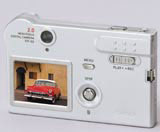A digital challenge
Matthew Valentine finds Casio’s new slim-line Exilim EX-S2 digital camera easy on the eye, but a lot harder to get a grip on

Professional photographers can be a funny lot. Generally they are gadget crazy, but a significant proportion of them are reluctant to fully back digital photography. There are several reasons for this: the cost of new equipment; a reluctance to learn new ways of working; and – the one they won’t admit to – the fact that the technology puts an end to their near-exclusive grasp of the alchemy that is film processing. But for the happy snapper, digital photography promises hours of fun without the wait for films to come back in the post. Pictures can now be e-mailed to friends and family within minutes, and even some mobile phones are capable of taking, sending and receiving them. For cameras to offer a significant benefit over the ubiquitous mobile they will now need to offer a lot of extra features, hence new models like the Casio Exilim EX-S2. An updated version of the EX-S1 model, the Exilim now offers a resolution of two million pixels – far better than any phone. Visually, the Exilim is a sleek, silver thing, from a similar mould to rival Canon’s near-iconic Ixus, but without that model’s reassuring heft and hewn-from-something-solid controls. In a direct comparison of perceived quality, a two-year-old Ixus wins hands down, making the Exilim seem fragile and plastic-like, despite its claim to be made of stainless steel. Less than 1cm thick, but with other dimensions almost identical to the APS Ixus, the new model is dubbed by Casio as a Wearable Card Camera. Small it certainly is. And, as with anything that is difficult to get a firm grip on, the Exilim doesn’t always benefit from its miniaturisation. The main toggle control on the back – used to navigate through menus – needs nimble fingers to avoid a frustrating gallop through the options, even for dexterous Playstation-generation digits. Size does matter sometimes. The natural place to grasp the camera put my left index finger directly in front of the lens, and it seems positively contrary that a camera which will surely be carried in a pocket comes without a lens cap. Cue smudges and thumb prints. Other design factors struck a sour note: the small aperture used to fix the camera to its neat USB docking bay (for transfer of images to computer) is covered by a small rubber plug, which I very nearly lost the first time I removed it. This component just begs to fall down the back of a sofa or into a puddle. Casio makes much of its new camera’s design – created in-house and overseen by Susumu Takashima – in its publicity material for tomorrow’s launch. And it appears to be charging a premium for it, even if in practice the design isn’t as well thought through as it might be. Too many small drawbacks spoil the functionality of what is otherwise a very clever device. A professional photographer I drafted in to try out the Exilim pronounced it a ‘really neat toy’, and found the included software simple to use. But she balked at the price, especially after making a few comparisons. To be fair, the Exilim is not targeted at professionals; Casio says it is aimed at ‘anyone with an appreciation of style and design’ – and, presumably, a willingness to pay through the nose for it. But checking somewhere as basic as an Argos catalogue shows that there are plenty of two million-pixel digital cameras available for far less than the Exilim’s £299 price tag.
-
Post a comment



